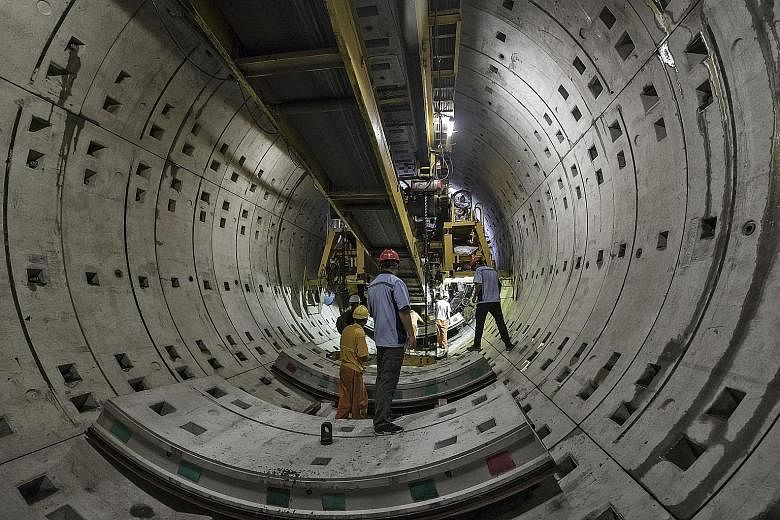SHANGHAI • Deep under Shanghai, workers on a flood-lit construction rig carefully install massive concrete wall sections for a new subway tunnel, adding metre by metre to the world's longest metro system.
The Shanghai metro's future Line 14 is part of plans to extend the already sprawling network another 35 per cent by 2020 to 830km - more than the distance from New York to Chicago.
Yet, Shanghai is just one player in an unprecedented subway-building boom as China's massive cities race to keep pace with rising urban populations.
In 2001, four Chinese cities, including Beijing and Shanghai, had rather limited networks.
By the end of last year, there were around 30, including some of the world's longest and busiest networks, and about a dozen more cities have got the green light.
State media reports say Chinese spending on subway construction could top 2 trillion yuan (S$400 billion ) from 2016 to 2020 alone.
"(China is seeing) the fastest period in human history for the development of metro systems. It's quite remarkable," said Mr Liu Daizong, a World Resources Institute transport expert in Beijing.
-
SHANGHAI METRO UPGRADE
-
35%
Planned extension of Shanghai metro system by 2020.
-
830km
Length when completed.
Usually reserved for first-tier cities, subways are running even in third-tier population centres far inland. The driving factor is a massive shift of humanity to Chinese cities.
Only around 12 per cent of Chinese were urban dwellers in 1950.
Today, the rate is about 55 per cent and targeted to rise by 2030 to 70 per cent - or around one billion people.
Officially encouraged to lift millions from rural poverty and fuel economic growth, urbanisation has also brought congestion, pollution and sprawl.
Shanghai's population has nearly doubled since 2000 to 24 million - China's largest - and is on course for 30 million by 2030. Its traffic jams are legendary.
To keep up, its metro system has roughly doubled in the past decade and, on April 28, handled a record 11.86 million individual trips.
Along with those in Tokyo and Beijing, the network is among the world's top three busiest and has grown so much that there are plans to connect it with the metro of the neighbouring city of Suzhou more than 100km away.
But challenges have emerged - new Shanghai lines must be dug as deep as a 15-storey building to squeeze under the maze of existing tunnels, said Mr Zhou Xisheng, an engineer with state-run Shentong Metro Group which runs the system.
"As the depth increases, so does the difficulty... and the price," Mr Zhou said, standing next to a giant pit during a government tour of new construction.
Metro construction is notoriously expensive and questions hover over China's ability to pay for all the plans.
But Ms Lillian Li, a Shanghai- based credit expert with Moody's, said ruling Communist Party support should see projects through.
"Transport is a key infrastructure sector that the government would like to support for (national) integration and coordination. That's looking pretty good," Ms Li said.
The building spree is part of larger visions sketched out by planners that include the development of massive "city clusters" such as one grouping Shanghai and nearby cities like Suzhou and Hangzhou that could top 50 million people.
Such urban agglomerations would connect to nearby lower-tier cities and other regions of China via fast-expanding, high-speed rail systems, enhancing the flow of labour, financing, resources and administrative expertise, experts said.
The resulting bonanza of infrastructure investment, likewise, will boost the national objective of spurring domestic consumption to lessen China's reliance on volatile overseas trade, said Professor Zhu Dajian, a sustainable development expert at Tongji University.
"Subways solve a lot of problems, raise the quality of a city, and reduce driving time and energy consumption," he said. "In 10 to 20 years, this path will be proven correct."
AGENCE FRANCE-PRESSE

